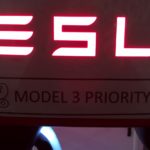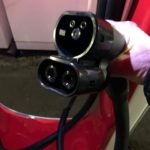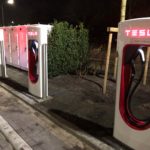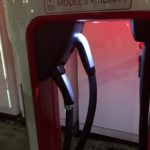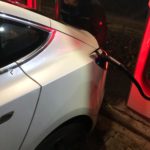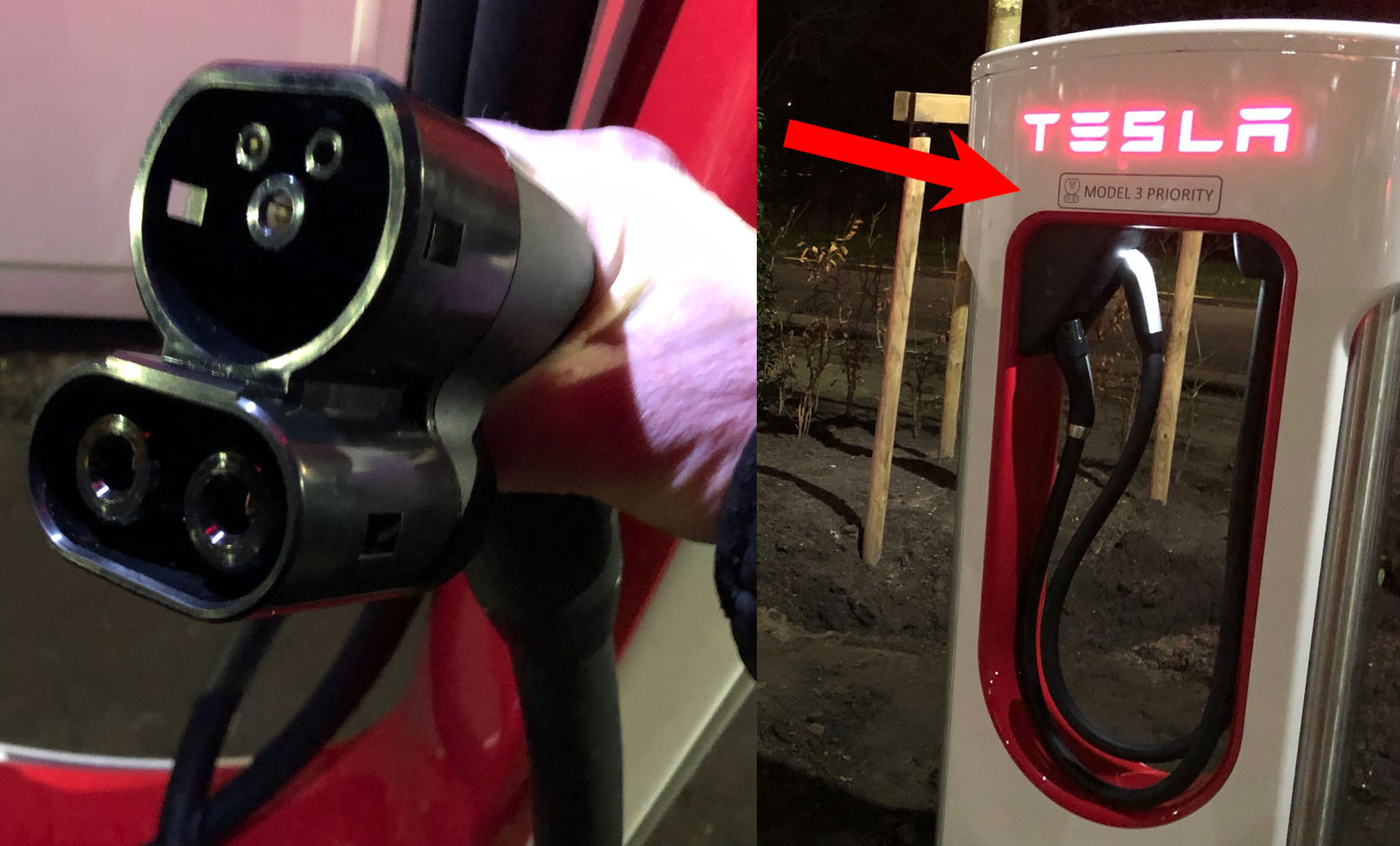

News
Tesla begins Supercharger CCS upgrade ahead of Model 3 rollout in Europe
It is still a couple of months before Model 3 deliveries in Europe are expected to begin, but Tesla is already starting the rollout of dual-charge CCS Superchargers in the region. The company confirmed last month that the Model 3 will be getting a CCS plug for Europe, while a CCS adapter will be introduced for the Model S and X. During its announcement for the Model 3’s charging standard for the region, Tesla noted that it would be “retrofitting our existing Superchargers with dual charge cables to enable Model 3, which will come with a CCS Combo 2 charge port, to use the Tesla Supercharger network.”
Tesla’s adoption of CCS (Combined Charging System) is a notable step for the electric car maker. CCS, after all, is prevalent in the region, being preferred by several European carmakers including BMW, Volkswagen and the Daimler group. The system combines the Type 2 design, which is used for slower AC charging at home or work, as well as with two large DC pins for rapid charging. CCS competes with the CHAdeMO rapid charging standard, which is being used by companies such as Nissan, Mitsubishi and Subaru.
Tesla owner-enthusiast Hans Noordsij visited the site of Tesla’s first dual charge Supercharger station, where he was able to take photos and meet Tesla staff who were working on the updated charging stall. Several details of the upgraded Supercharger were evident from Hans’ images, including a sign indicating that the new stations are “Model 3 Priority.”
- One of Tesla’s first dual-charge, CCS-compatible Superchargers in Europe. (Photo: Hans Noordsij)
- A close-up of Tesla’s CCS plug for the Model 3. (Photo: Hans Noordsij)
- One of Tesla’s first dual-charge, CCS-compatible Superchargers in Europe. (Photo: Hans Noordsij)
One of Tesla’s first dual-charge, CCS-compatible Superchargers in Europe. (Photo: Hans Noordsij)
Speaking to Teslarati after his trip to the Supercharger, Hans noted that Tesla was testing the connection of a Model 3 to the dual charge station when he arrived. Tesla’s staff reportedly informed him that they were aiming to add CCS connectors to every Supercharger in the Netherlands sometime in January.
We reached out to Tesla for more information about its first dual charge CCS Supercharger in Europe. The electric car maker noted that the first upgraded stations are located at the Badhoevedorp Supercharger near the Corendon Village Hotel, just outside Amsterdam. The site currently has 20 Superchargers, and Tesla is installing 8 more stalls on the site, each of which is fitted with both a CCS and a Type 2 connector. When completed, 8 out of the 28 stalls in the location would be compatible with the Model 3, S, and X, while the remaining 20 would be compatible with the flagship sedan and SUV.
Tesla plans to fully retrofit Europe’s Supercharger Network with its dual charge CCS system, allowing the Model 3 to have access to Tesla’s expansive charging infrastructure. While Tesla is in the process of retrofitting its Superchargers with CCS plugs, though, Model 3 owners in the region could expect their vehicles to smartly suggest charging stations that are fitted with the necessary connectors. The location, as well as the availability of these CCS stalls, would be displayed on the Model 3’s display.
- A Tesla Model 3 gets connected to one of Tesla’s first dual-charge, CCS-compatible Superchargers in Europe. (Photo: Hans Noordsij)
- One of Tesla’s first dual-charge, CCS-compatible Superchargers in Europe. (Photo: Hans Noordsij)
- A Tesla Model 3 gets connected to one of Tesla’s first dual-charge, CCS-compatible Superchargers in Europe. (Photo: Hans Noordsij)
A Tesla Model 3 gets connected to one of Tesla’s first dual-charge, CCS-compatible Superchargers in Europe. (Photo: Hans Noordsij)
Europe is a pivotal part of Tesla’s strategy for the Model 3, considering that the premium sedan segment is twice as big in the region as it is in the United States. The Model 3 is already performing well in the US, despite the country being enamored by SUVs and pickup trucks. In a market where sedans are prevalent such Europe, the Model 3’s potential is vast.
Considering that Tesla is now rolling out CCS plugs on its European Supercharger Network, the idea of Tesla sharing its charging infrastructure with other electric cars emerges once more. Tesla’s head of global charging infrastructure, Drew Bennett, addressed this in an interview with Auto Express UK, where he noted that several EV makers have already reached out to Tesla about sharing the Supercharger Network.
“We’re definitely open to talking to other car manufacturers who want to have access to the network. Capacity is a driver for our investment; it’s new routes, new markets and then capacity. A lot of car makers have spoken to us about it, but we haven’t had any conclusive discussions on it. They’re still trying to figure out what they would need in a network, but we’re a couple of years ahead of them in terms of embracing the investment required to transition to EVs,” Bennett said.
Elon Musk
Tesla reveals it is using AI to make factories more sustainable: here’s how
Tesla is using AI in its Gigafactory Nevada factory to improve HVAC efficiency.

Tesla has revealed in its Extended Impact Report for 2024 that it is using Artificial Intelligence (AI) to enable its factories to be more sustainable. One example it used was its achievement of managing “the majority of the HVAC infrastructure at Gigafactory Nevada is now AI-controlled” last year.
In a commitment to becoming more efficient and making its production as eco-friendly as possible, Tesla has been working for years to find solutions to reduce energy consumption in its factories.
For example, in 2023, Tesla implemented optimization controls in the plastics and paint shops located at Gigafactory Texas, which increased the efficiency of natural gas consumption. Tesla plans to phase out natural gas use across its factories eventually, but for now, it prioritizes work to reduce emissions from that energy source specifically.
It also uses Hygrometric Control Logic for Air Handling Units at Giafactory Berlin, resulting in 17,000 MWh in energy savings each year. At Gigafactory Nevada, Tesla saves 9.5 GWh of energy through the use of N-Methylpyrrolidone refineries when extracting critical raw material.
Perhaps the most interesting way Tesla is conserving energy is through the use of AI at Gigafactory Nevada, as it describes its use of AI to reduce energy demand:
“In 2023, AI Control for HVAC was expanded from Nevada and Texas to now include our Berlin-Brandenburg and Fremont factories. AI Control policy enables HVAC systems within each factory to work together to process sensor data, model factory dynamics, and apply control actions that safely minimize the energy required to support production. In 2024, this system achieved two milestones: the majority of HVAC infrastructure at Gigafactory Nevada is now AI-controlled, reducing fan and thermal energy demand; and the AI algorithm was extended to manage entire chiller plants, creating a closed-loop control system that optimizes both chilled water consumption and the energy required for its generation, all while maintaining factory conditions.”
Tesla utilizes AI Control “primarily on systems that heat or cool critical factory production spaces and equipment.” AI Control communicates with the preexisting standard control logic of each system, and any issues can be resolved by quickly reverting back to standard control. There were none in 2024.
Tesla says that it is utilizing AI to drive impact at its factories, and it has proven to be a valuable tool in reducing energy consumption at one of its facilities.
Elon Musk
Tesla analysts believe Musk and Trump feud will pass
Tesla CEO Elon Musk and U.S. President Donald Trump’s feud shall pass, several bulls say.

Tesla analysts are breaking down the current feud between CEO Elon Musk and U.S. President Donald Trump, as the two continue to disagree on the “Big Beautiful Bill” and its impact on the country’s national debt.
Musk, who headed the Department of Government Efficiency (DOGE) under the Trump Administration, left his post in May. Soon thereafter, he and President Trump entered a very public and verbal disagreement, where things turned sour. They reconciled to an extent, and things seemed to be in the past.
However, the second disagreement between the two started on Monday, as Musk continued to push back on the “Big Beautiful Bill” that the Trump administration is attempting to sign into law. It would, by Musk’s estimation, increase spending and reverse the work DOGE did to trim the deficit.
Every member of Congress who campaigned on reducing government spending and then immediately voted for the biggest debt increase in history should hang their head in shame!
And they will lose their primary next year if it is the last thing I do on this Earth.
— Elon Musk (@elonmusk) June 30, 2025
President Trump has hinted that DOGE could be “the monster” that “eats Elon,” threatening to end the subsidies that SpaceX and Tesla receive. Musk has not been opposed to ending government subsidies for companies, including his own, as long as they are all abolished.
How Tesla could benefit from the ‘Big Beautiful Bill’ that axes EV subsidies
Despite this contentious back-and-forth between the two, analysts are sharing their opinions now, and a few of the more bullish Tesla observers are convinced that this feud will pass, Trump and Musk will resolve their differences as they have before, and things will return to normal.
ARK Invest’s Cathie Wood said this morning that the feud between Musk and Trump is another example of “this too shall pass:”
BREAKING: CATHIE WOOD SAYS — ELON AND TRUMP FEUD “WILL PASS” 👀 $TSLA
She remains bullish ! pic.twitter.com/w5rW2gfCkx
— TheSonOfWalkley (@TheSonOfWalkley) July 1, 2025
Additionally, Wedbush’s Dan Ives, in a note to investors this morning, said that the situation “will settle:”
“We believe this situation will settle and at the end of the day Musk needs Trump and Trump needs Musk given the AI Arms Race going on between the US and China. The jabs between Musk and Trump will continue as the Budget rolls through Congress but Tesla investors want Musk to focus on driving Tesla and stop this political angle…which has turned into a life of its own in a roller coaster ride since the November elections.”
Tesla shares are down about 5 percent at 3:10 p.m. on the East Coast.
Elon Musk
Tesla scrambles after Musk sidekick exit, CEO takes over sales
Tesla CEO Elon Musk is reportedly overseeing sales in North America and Europe, Bloomberg reports.

Tesla scrambled its executives around following the exit of CEO Elon Musk’s sidekick last week, Omead Afshar. Afshar was relieved of his duties as Head of Sales for both North America and Europe.
Bloomberg is reporting that Musk is now overseeing both regions for sales, according to sources familiar with the matter. Afshar left the company last week, likely due to slow sales in both markets, ending a seven-year term with the electric automaker.
Tesla’s Omead Afshar, known as Elon Musk’s right-hand man, leaves company: reports
Afshar was promoted to the role late last year as Musk was becoming more involved in the road to the White House with President Donald Trump.
Afshar, whose LinkedIn account stated he was working within the “Office of the CEO,” was known as Musk’s right-hand man for years.
Additionally, Tom Zhu, currently the Senior Vice President of Automotive at Tesla, will oversee sales in Asia, according to the report.
It is a scramble by Tesla to get the company’s proven executives over the pain points the automaker has found halfway through the year. Sales are looking to be close to the 1.8 million vehicles the company delivered in both of the past two years.
Tesla is pivoting to pay more attention to the struggling automotive sales that it has felt over the past six months. Although it is still performing well and is the best-selling EV maker by a long way, it is struggling to find growth despite redesigning its vehicles and launching new tech and improvements within them.
The company is also looking to focus more on its deployment of autonomous tech, especially as it recently launched its Robotaxi platform in Austin just over a week ago.
However, while this is the long-term catalyst for Tesla, sales still need some work, and it appears the company’s strategy is to put its biggest guns on its biggest problems.
-

 Elon Musk1 day ago
Elon Musk1 day agoTesla investors will be shocked by Jim Cramer’s latest assessment
-

 News6 days ago
News6 days agoTesla Robotaxi’s biggest challenge seems to be this one thing
-

 News2 weeks ago
News2 weeks agoTesla’s Grok integration will be more realistic with this cool feature
-

 Elon Musk2 weeks ago
Elon Musk2 weeks agoElon Musk slams Bloomberg’s shocking xAI cash burn claims
-

 News2 weeks ago
News2 weeks agoTesla China roars back with highest vehicle registrations this Q2 so far
-

 News2 weeks ago
News2 weeks agoTexas lawmakers urge Tesla to delay Austin robotaxi launch to September
-

 News2 weeks ago
News2 weeks agoTesla dominates Cars.com’s Made in America Index with clean sweep
-

 Elon Musk1 week ago
Elon Musk1 week agoFirst Look at Tesla’s Robotaxi App: features, design, and more

